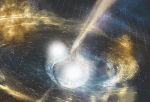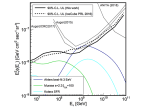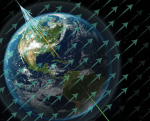The IceCube Collaboration has just performed its first measurement of tau neutrino appearance in oscillations of atmospheric muon neutrinos, which excluded the absence of tau neutrino oscillations at a significance of 3.2σ, confirming previous observations by OPERA and Super-Kamiokande. These results have just been submitted to the journal Physical Review D. […]
Research
IceCube and HAWC unite efforts to dissect the cosmic-ray anisotropy
In an attempt to better understand the anisotropy, the IceCube Neutrino Observatory and the HAWC gamma-ray observatory have united their efforts to study cosmic-ray arrival directions in both hemispheres at the same primary energy. The goal of this combined observation was to get a nearly full-sky coverage to study the propagation of cosmic rays with median energy of 10 TeV through our local interstellar medium as well as the interactions between interstellar and heliospheric magnetic fields. Results have just been accepted for publication in The Astrophysical Journal and include measurements on how the anisotropy modulations are distributed over different angular scales. […]
A view of the Milky Way with IceCube and ANTARES
Neutrinos allow us to test our models at higher energies than do gamma rays. In a first-time effort to combine IceCube and ANTARES data to constrain galactic cosmic-ray models, scientists from both collaborations have set new limits on some of these models as well as a new limit for the galactic contribution to the IceCube neutrino flux. These results have been published this week in the journal Astrophysical Journal Letters. […]
Steady point sources of cosmic neutrinos remain unresolved
In a new attempt to lay siege to the steady sources of neutrinos, the IceCube Collaboration has improved the search for sources in the Northern Hemisphere using muon neutrino data. The new search with eight years of IceCube data and an upgraded event selection and reconstruction resulted in enhanced sensitivity and the most stringent limits yet on emission from steady sources. These results have just been submitted to the journal European Physical Journal C . […]
Multimessenger searches for sources of gravitational waves and neutrinos
The IceCube, LIGO, Virgo, and ANTARES collaborations have used data from the first observing period of Advanced LIGO and from the two neutrino detectors to search for coincident neutrino and gravitational wave emission from transient sources. Scientists did not find any significant coincidence. The results, recently submitted to The Astrophysical Journal, set a constraint on the density of these sources. […]
The Sun also casts a shadow on IceCube
The IceCube Collaboration has measured the Sun’s cosmic-ray shadow for the first time, from data covering a period of five years. The results, submitted today to The Astrophysical Journal, show a clear but different shadow pattern every year. When looking at the yearly variation, scientists have found that the shadow pattern follows changes in the solar activity, which we know are correlated with the strength of the Sun’s magnetic field. Thus, this study opens a new line of research for the Antarctic neutrino observatory: the study of the Sun’s magnetic field using IceCube cosmic-ray data. […]
The hardest search yet: cosmogenic neutrinos wait for next generation detectors
The IceCube Collaboration has, once more, looked for extremely high-energy neutrinos. And now, after analyzing nine years of IceCube data, scientists set the most stringent limits on the existence of cosmogenic neutrinos to date. As a result, the idea that ultra-high-energy cosmic rays are mostly protons is vanishing. These results were published in the journal Physical Review D last week. […]
Understanding inelasticity in high-energy neutrino interactions with IceCube
The IceCube Collaboration has recently presented its first measurements of the neutrino inelasticity, which are also the first-ever at very high energies—from 1 TeV up to nearly 800 TeV. The inelasticity distribution was found to be in good agreement with Standard Model prediction and was later used to perform other measurements, such as charm production in neutrino interactions or flavor composition of astrophysical neutrinos. […]
Constraints on neutrino emission from short-lived transient sources
In a new search for neutrino sources, the IceCube Collaboration and other collaborators have looked for short-lived transient sources, including gamma-ray bursts, core-collapse supernovae, or neutron star mergers. The search, which looked for two or more neutrinos detected within 100 seconds from the same location, included transients that might not emit gamma rays and might be pointing to uncharted objects in the universe. The results submitted this week to Physical Review Letters did not identify any individual source but did show that the number of bright short-lived transient neutrino sources must be small or they must be fairly faint. […]
IceCube neutrinos pass a test of a fundamental symmetry in nature
A new measurement of the IceCube Collaboration has put Lorentz symmetry to the test and found—yet again—that neutrinos behave as expected. The results, published in Nature Physics, are the most stringent limits to date in the neutrino sector on the existence of a Lorentz violating field. […]









